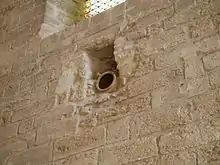Acoustic jar
Acoustic jars, also known by their Greek name echea (ηχεία), are ceramic vessels found set into the walls, and sometimes into the sides of cavities beneath the floors, of medieval churches. They are believed to have been intended to improve the sound of singing, and to have been inspired by the theories of Vitruvius .

History
Tuned bronze vases set in niches were used to modify the acoustics in Greek and Roman theatres. Their use is described by Vitruvius.[1] No original examples survive.[2]
In the Middle Ages the idea of the acoustic vessel re-emerged. Examples have been found in around 200 churches, half of them in France.[2] They vary greatly in shape and positioning, but, unlike those described by Vitruvius they are ceramic, and are found enclosed within the fabric of building.[2] The function of the jars was established with the discovery of a reference in the Chronicle of the Celestins of Metz. The chronicler recorded that, in 1432:
on the vigil of the Assumption, after brother Odo le Roy, the prior, had returned from the before-mentioned general chapter, it was ordered that pots should be put into the choir of the church of this place, he stating that he had seen such in a church elsewhere thinking that they made the singing better, and resound more, they were put up there in one day, by taking as many workmen as were necessary.[3]
Modern experiments have indicated that their effect would have been to absorb the resonance of certain frequencies, rather than to amplify sound.[2]
They use of the jars was said to be common in Brittany, and around Clisson, in the Loire Inferieure. In the Clisson area, they were usually found in horizontal rows at a height of about three metres above floor level.[4] In 1859 a correspondent to Archaeologia Cambrensis reported that at Pallet there was "a modern chapel, with earthenware vessels inserted in the walls of the choir, expressly for acoustic purposes".[4] In England, a set of eleven jars survives high on the chancel walls of St Andrews church at Lyddington, Rutland.[5]
At St Peter Mancroft in Norwich two L-shaped trenches accommodating a number of acoustic jars were discovered beneath the wooden floor on which the choir stalls had previously stood. They had rubble walls and concrete bottoms, and the surfaces were rendered over. Earthenware jars were built into the walls at intervals of about three feet, with the mouths facing into the trench. The jars were about 9 ½ inches long, and 8 inches across at their widest, narrowing to 6 inches at the mouth. A similar discovery was made at St Peter Parmentergate, Norwich in the same city.[6] At Fountains Abbey, in Yorkshire several earthenware vessels were discovered mortared into the base of the choir screen, their necks protruding through the stonework.[7]
The effectiveness of the medieval jars has sometimes been doubted. The Chronicler of Metz, in the only medieval source for the purpose of the jars, mocks the prior for believing that they might have improved the sound of the choir,[3] and the archaeologist Ralph Merrifield suggested that their use might have owed more to a tradition of votive deposits than to the theories of Vitruvius.[8]
In 2011, at The Acoustics of Ancient Theatres conference, held in Patra, Greece, P. Karampatzakis and V. Zafranas presented evidence that Vitruvius' theory was in fact correct, and that the reconstruction of an ancient acoustic vase is possible.[9][10]
See also
References
- Godman, Rob. "The enigma of Vitruvian Resonating Vases and the Relevance of the Concept for Today" (PDF). Retrieved 14 May 2013.
- Crunelle, Marc. "Is There an Acoustical Tradition in Western Architecture?" (PDF).
- Minns, G.W. (1872). "Acoustic Pottery in Norwich Churches". Norfolk Archaeology. 7: 96.
- "Acoustic Contrivances in Churches And Other Buildings". Archaeologia Cambrensis: 139–42. 1859.
- "St Andrew's Church". Openair. Archived from the original on 13 July 2018. Retrieved 19 August 2016.
- Phipson, Makilwane (1863). "Acoustic Pottery". The Builder: 893.
- Andrews, William (1897). Antiquities and Curiosities of the Church. London: William Andrews. pp. 39–40.
- Merrrifield, Ralph (1969). "Folk-lore in London Archaeology. Part 2: The Post-Roman period" (PDF). The London Archaeologist: 99–105.
- Acoustics of Ancient Theatres conference
- Karampatzakis P. Zafranas V. Polichronopoulos S 2011 http://ikee.lib.auth.gr/record/127577/files/A%20study%20on%20Aristoxenus%20acoustic%20urns.pdf